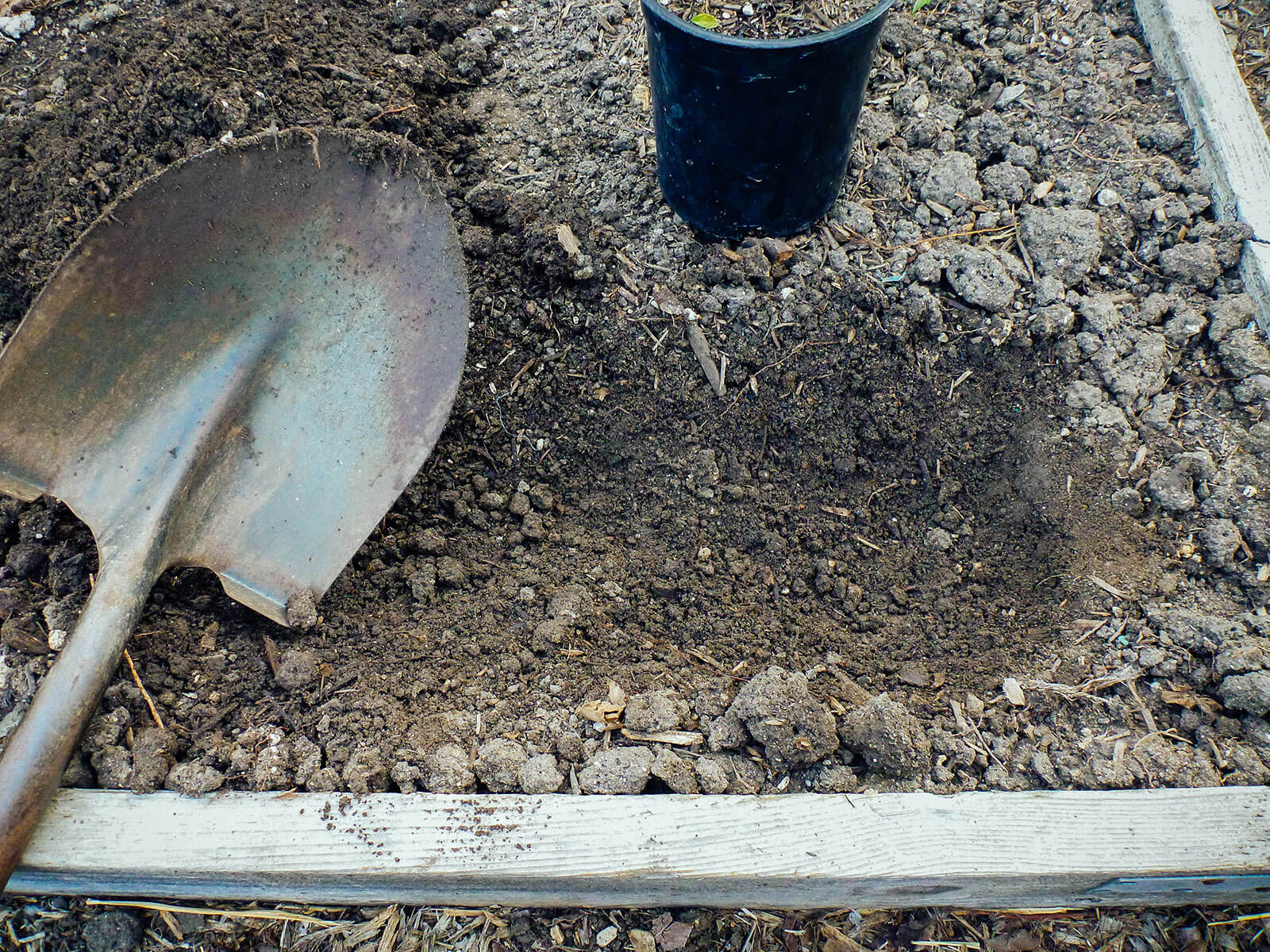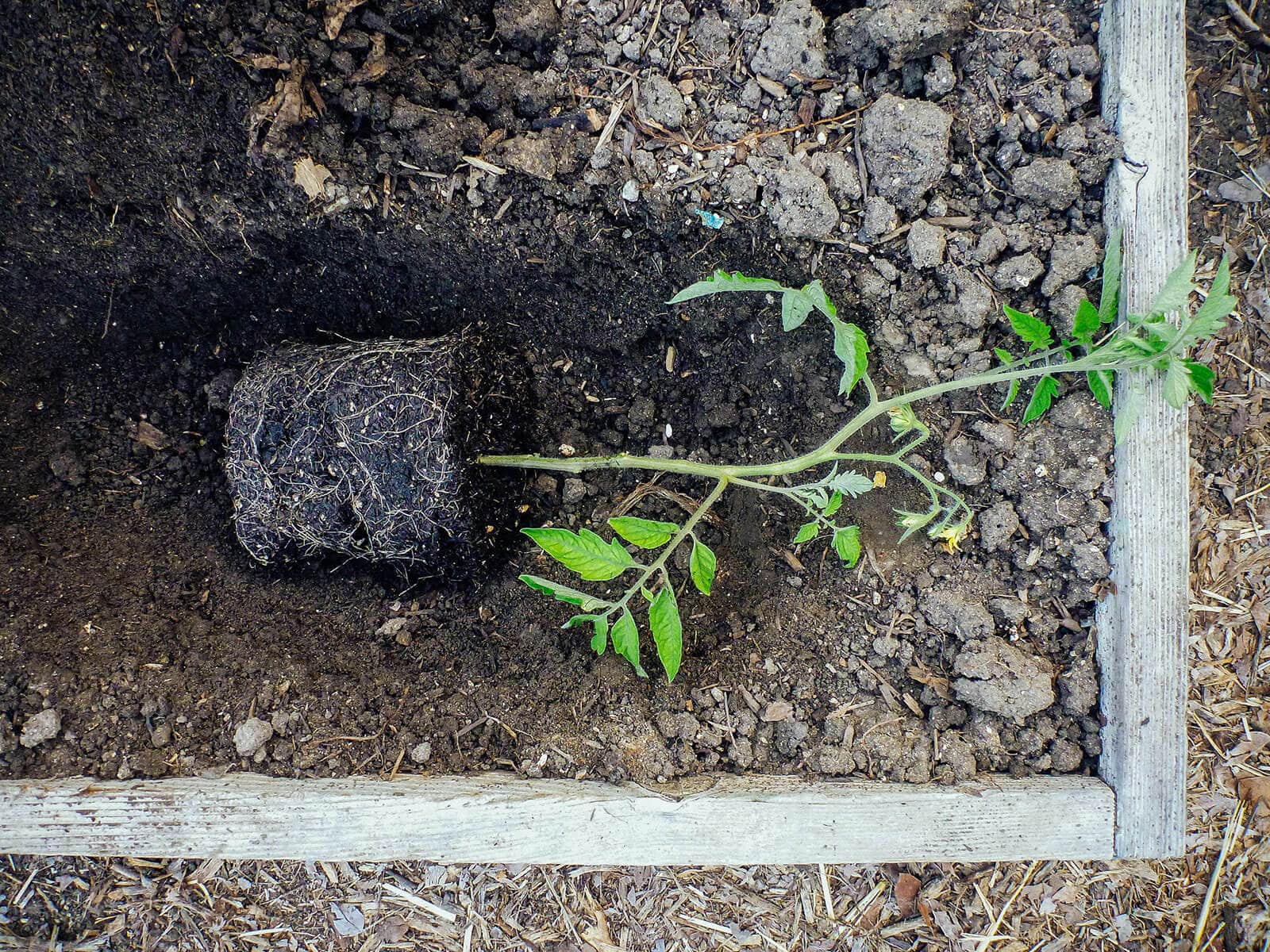At this stage in your tomato growing game, you’ve probably started your seeds indoors, repotted your tomato seedlings, and transplanted those tomatoes a second time into a larger container to build up the root system.
Now your well-developed tomato plant is ready to go in the ground, but if your plant looks anything like mine, digging a 2-foot-deep hole to bury the stem more deeply is a bit out of the question.
If you want to save your back and speed up this last step in transplanting tomatoes, here’s a simple technique that many seasoned gardeners have in their bag of tricks: planting tomatoes in a trench.

The ultimate tomato planting hack
Planting tomatoes in a trench (or trough) is exactly how it sounds: digging a shallow trench, placing your plant sideways in the hole, and backfilling the hole just enough to cover the bottom portion of the stem.
The rest of the plant (with all the branches and leaves) simply rests on the soil. (But don’t worry, it won’t stay that way.)
If your tomato starts have gotten too tall by the time you’re ready to transplant them, this type of shallow planting not only saves time, it saves you from all the digging you would’ve had to do to transplant a tomato properly.
Read more: Lazy Gardening: 11 Time-Saving Tips for Getting More Out of Your Garden By Doing Less
Planting your tomatoes sideways is a simple trick that works for leggy transplants which may not have gotten enough sun the first couple months, as well as taller transplants which may not have been up-potted. (A common issue with transplants you buy from a nursery or garden center.)

But you can also do this with a well-developed transplant that’s growing normally, as every tomato plant benefits from the technique.
Why should you plant tomatoes sideways?
Short answer: It’s all about the adventitious roots.
The trenching method takes advantage of a tomato plant’s ability to grow roots along its stem. When part of the stem is buried, it stimulates new root growth wherever the stem is in contact with moisture and soil.
While this might sound strange—and it kind of is, as most other plants don’t like having their stems buried—tomatoes (particularly heirloom tomatoes) will produce small, short growths on their stems that first resemble bumps, then become more bristle-like. As these growths get larger, they begin to look like roots.

These are the adventitious roots (also called root initials or tomato stem primordial) that are the earliest stages of root development. They’re generally found on the lower branches of tomato plants, but may be found higher up on the stem.
Adventitious roots are caused by plant genetics and usually appear in times of stress (particularly water stress). But they, themselves, aren’t harmful to your tomato and are considered normal in the plant’s development.
Read more: 7 Hot-Weather Watering Tips to Survive a Heat Wave
If placed in contact with soil, adventitious roots will grow into full-blown roots, strengthening the plant’s root system.
As mentioned in my previous post on repotting tomatoes, the bigger the root mass, the tougher and more resilient the tomato plant will be against pests and diseases in the garden. Bigger roots also mean better drought resistance and better uptake of nutrients.
I want to emphasize that last part: better uptake of nutrients. When you have a robust root system (coupled with consistent moisture), your tomato plant is less likely to suffer from blossom end rot (a condition caused by poor uptake of calcium in the soil).
Soooo… Let’s say you did all the right things and your twice-transplanted tomato plant is 3 feet tall at this point. Does that mean you need to get 2 feet of stem in the ground so it can grow vast amounts of roots?
Well, if you have a lot of clay, rocks, or dirt clods in your soil (like I did in these pictures, when I was gardening in clay soil in California) or your mobility is limited, it just doesn’t make sense (or sound pleasant) to spend the day with your shovel and dig waaaay down there. (I am all about lazy gardening, after all.)
Planting your tomatoes sideways, or horizontally, in a shallow trough allows you to dig much less, while also putting your plant in the upper layer of soil. This is where the richest nutrients are found, and the warmer soil helps accelerate plant growth.
If you live in a cooler climate where the soil takes a while to warm up in spring, trenching your tomatoes can help your plants get going faster.
Related: Find First and Last Frost Dates Accurately with This Custom Planting Calendar
Since most of the root mass will be near the surface, water and fertilizer will also be able to reach the roots more evenly. If you have less-than-perfect soil (not as well-draining as you thought it was, or as loamy as you’d like), the trenching technique actually works in your favor in many ways!
How to plant tomatoes in a trench (trough)
Step 1: Pick the right day to transplant.
Start by choosing a calm, and overcast or partially sunny day to transplant your tomato. This puts less stress on the plant while it’s adjusting to the outdoors. If you’ve hardened off your transplants already, there should be little to no setback.
Plant in the late afternoon to evening to give your tomato a chance to settle in overnight before a full day of bright sun.
Step 2: Dig your trench in well-amended soil.
If you’re unsure on how to amend your soil properly for transplanting tomatoes, follow these tomato growing tips first.
Begin by digging a long trench (trough) about 4 to 6 inches deep, with a slightly deeper pocket on one end for the root ball.

Step 3: Place your tomato plant sideways in the trench.
Lay the tomato plant on its side in the trench, taking care not to damage the stem. Pinch or snip off the lowest two to three sets of branches.
You should end up with just a top cluster of healthy leaves and several inches of bare stem.

Step 4: Fill the trench with soil.
Cover the root ball and newly exposed stem with soil, up to the lowest branch. Fill in the areas around the rest of the plant with more soil, so that the trench is completely filled in and the soil is level.
The plant will be oriented horizontally with its leaves and stem on the ground. Don’t worry, this is what it’s supposed to look like for now.

Step 5: Water the tomato plant.
Water your plant thoroughly, keeping in mind the roots are off to the side so you’ll want to concentrate the water there.
Try to keep moisture off the foliage, as they’re particularly susceptible to disease if they’re sitting in a pool of water.
Within the next sunny day or two, the plant will start to reposition itself upright and continue to grow vertically like normal. It’s kind of like magic!
If you anticipate a period of cloudy weather following the transplant, you can set a rock under the stem to help get it started in the right direction.


Once all your tomato plants have turned themselves upright, try to stake, cage, or trellis them as soon as possible.
If you have a few tomato plants growing in a row, the Florida Weave trellising method is my favorite way to prop everything up easily and economically. (Just remember where the roots are buried so you don’t accidentally send a stake into the root ball!)
And as soon as you can, spread a 2- to 3-inch layer of mulch around your plants. These are the 12 best types of organic mulch that I recommend for all gardens.
How to Plant Tomatoes in a Trench

Have your tomato starts gotten too tall before you can transplant them? Here's a technique that many seasoned gardeners have in their bag of tricks: Plant them sideways in a trench (or trough) to save your back from digging!
Materials
- Tomato plant
Tools
- Shovel
Instructions
- Dig your trench in well-amended soil. Begin by digging a long trench (trough) about 4 to 6 inches deep, with a slightly deeper pocket on one end for the root ball.
- Place your tomato plant sideways in the trench. Lay the tomato plant on its side in the trench, taking care not to damage the stem. Pinch or snip off the lowest two to three sets of branches.
You should end up with just a top cluster of healthy leaves and several inches of bare stem. - Fill the trench with soil. Cover the root ball and newly exposed stem with soil, up to the lowest branch. Fill in the areas around the rest of the plant with more soil, so that the trench is completely filled in and the soil is level.
The plant will be oriented horizontally with its leaves and stem on the ground. Don’t worry, this is what it’s supposed to look like for now. - Water the tomato plant. Water your plant thoroughly, keeping in mind the roots are off to the side.
Within the next sunny day or two, the plant will start to reposition itself upright and continue to grow vertically like normal. It's kind of like magic!
Notes
If you anticipate a period of cloudy weather following the transplant, you can set a rock under the stem to help get it started growing upright.
This post updated from an article that originally appeared on June 24, 2011.
More tomato growing posts to explore:
- Grow Tomatoes Like a Boss With These 10 Easy Tips
- How to Grow Tomatoes in Pots—Even Without a Garden
- How to Best Fertilize Tomatoes for the Ultimate Bumper Crop
- How to Repot Tomato Seedlings for Bigger and Better Plants
- Why and How to Transplant Tomatoes (a Second Time)
- Planting Tomatoes Sideways: How Growing in a Trench Results In Bigger Healthier Plants
- Florida Weave: A Better Way to Trellis Tomatoes
- Conquer Blossom End Rot and Save the Harvest
- Can You Eat Tomato Leaves? The Answer Will Surprise You
- Why Tomato Leaves Have That Unique Smell
- The Power of Fermenting and Saving Tomato Seeds
- 4 Fastest Ways to Ripen Tomatoes in the Garden and Beat the First Frost
- The 30 Best Tasting Heirloom Tomato Varieties (By Color!)
- 83 Fast-Growing Short-Season Tomato Varieties for Cold Climates
- The Best Time to Pick Tomatoes for Peak Quality (It’s Not What You Think!)
View the Web Story on planting tomatoes sideways.
















We had a wind storm. I’m suspicious that one of my tomato plants might have had its central stalk broken (at least partially) under ground because it’s not as healthy looking as my other tomato plants. It is an heirloom variety. It is over 12” tall. Would I have better luck if I dug it up and trenched it? Or just keep watching it for signs of growth? Thanks!
Very Awesome & informative blog. It really helps me. Find out more about home & gardening tips
I’m so jazzed about tomatoes after reading ALL your related posts. I am going to give trench planting a try and maybe the Florida Weave trellising too. All good stuff! Thanks!
Awesome! Have fun experimenting!